Zenan Ling
Fundamental Bias in Inverting Random Sampling Matrices with Application to Sub-sampled Newton
Feb 19, 2025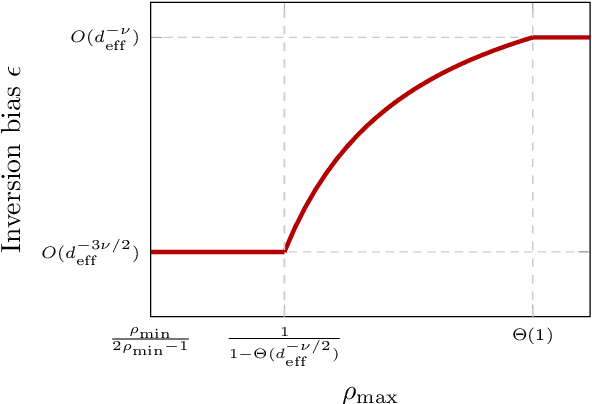
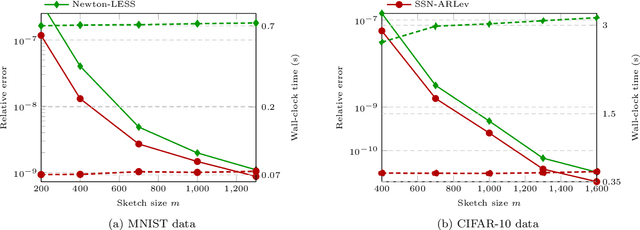
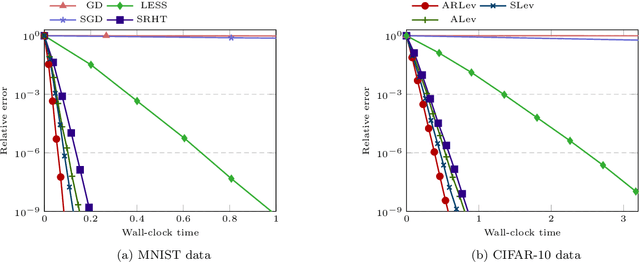
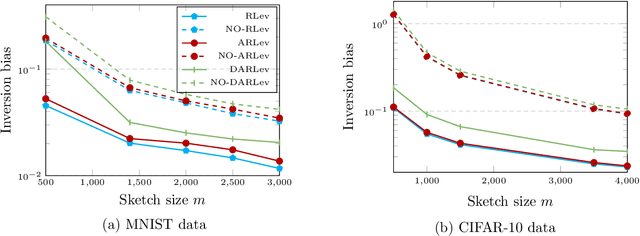
Abstract:A substantial body of work in machine learning (ML) and randomized numerical linear algebra (RandNLA) has exploited various sorts of random sketching methodologies, including random sampling and random projection, with much of the analysis using Johnson--Lindenstrauss and subspace embedding techniques. Recent studies have identified the issue of inversion bias -- the phenomenon that inverses of random sketches are not unbiased, despite the unbiasedness of the sketches themselves. This bias presents challenges for the use of random sketches in various ML pipelines, such as fast stochastic optimization, scalable statistical estimators, and distributed optimization. In the context of random projection, the inversion bias can be easily corrected for dense Gaussian projections (which are, however, too expensive for many applications). Recent work has shown how the inversion bias can be corrected for sparse sub-gaussian projections. In this paper, we show how the inversion bias can be corrected for random sampling methods, both uniform and non-uniform leverage-based, as well as for structured random projections, including those based on the Hadamard transform. Using these results, we establish problem-independent local convergence rates for sub-sampled Newton methods.
A Large-dimensional Analysis of ESPRIT DoA Estimation: Inconsistency and a Correction via RMT
Jan 06, 2025
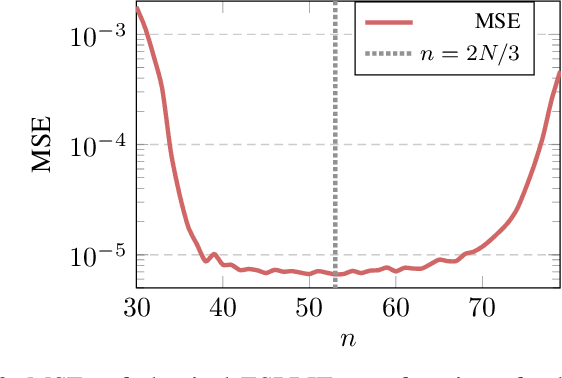
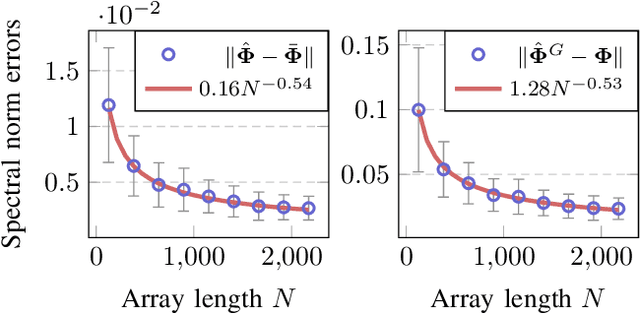
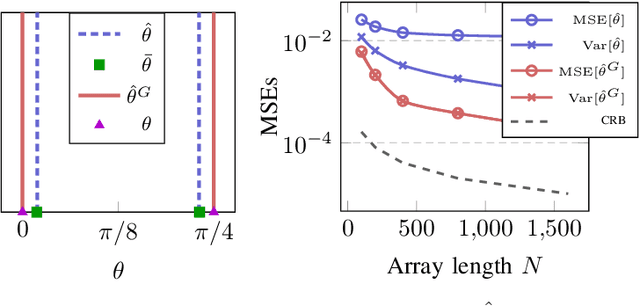
Abstract:In this paper, we perform asymptotic analyses of the widely used ESPRIT direction-of-arrival (DoA) estimator for large arrays, where the array size $N$ and the number of snapshots $T$ grow to infinity at the same pace. In this large-dimensional regime, the sample covariance matrix (SCM) is known to be a poor eigenspectral estimator of the population covariance. We show that the classical ESPRIT algorithm, that relies on the SCM, and as a consequence of the large-dimensional inconsistency of the SCM, produces inconsistent DoA estimates as $N,T \to \infty$ with $N/T \to c \in (0,\infty)$, for both widely- and closely-spaced DoAs. Leveraging tools from random matrix theory (RMT), we propose an improved G-ESPRIT method and prove its consistency in the same large-dimensional setting. From a technical perspective, we derive a novel bound on the eigenvalue differences between two potentially non-Hermitian random matrices, which may be of independent interest. Numerical simulations are provided to corroborate our theoretical findings.
Series-to-Series Diffusion Bridge Model
Nov 07, 2024



Abstract:Diffusion models have risen to prominence in time series forecasting, showcasing their robust capability to model complex data distributions. However, their effectiveness in deterministic predictions is often constrained by instability arising from their inherent stochasticity. In this paper, we revisit time series diffusion models and present a comprehensive framework that encompasses most existing diffusion-based methods. Building on this theoretical foundation, we propose a novel diffusion-based time series forecasting model, the Series-to-Series Diffusion Bridge Model ($\mathrm{S^2DBM}$), which leverages the Brownian Bridge process to reduce randomness in reverse estimations and improves accuracy by incorporating informative priors and conditions derived from historical time series data. Experimental results demonstrate that $\mathrm{S^2DBM}$ delivers superior performance in point-to-point forecasting and competes effectively with other diffusion-based models in probabilistic forecasting.
IGNN-Solver: A Graph Neural Solver for Implicit Graph Neural Networks
Oct 11, 2024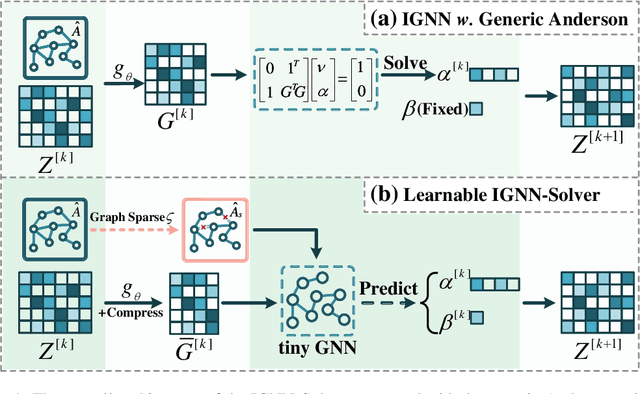
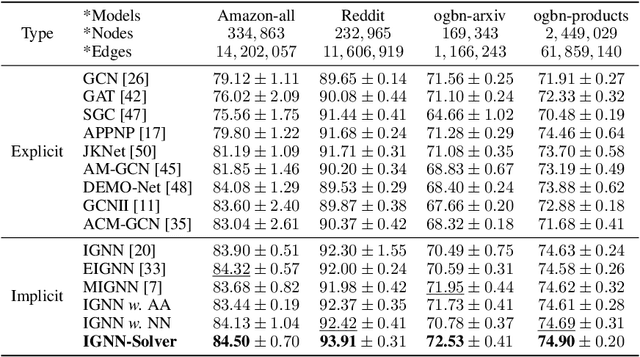


Abstract:Implicit graph neural networks (IGNNs), which exhibit strong expressive power with a single layer, have recently demonstrated remarkable performance in capturing long-range dependencies (LRD) in underlying graphs while effectively mitigating the over-smoothing problem. However, IGNNs rely on computationally expensive fixed-point iterations, which lead to significant speed and scalability limitations, hindering their application to large-scale graphs. To achieve fast fixed-point solving for IGNNs, we propose a novel graph neural solver, IGNN-Solver, which leverages the generalized Anderson Acceleration method, parameterized by a small GNN, and learns iterative updates as a graph-dependent temporal process. Extensive experiments demonstrate that the IGNN-Solver significantly accelerates inference, achieving a $1.5\times$ to $8\times$ speedup without sacrificing accuracy. Moreover, this advantage becomes increasingly pronounced as the graph scale grows, facilitating its large-scale deployment in real-world applications.
Nonstationary Sparse Spectral Permanental Process
Oct 04, 2024



Abstract:Existing permanental processes often impose constraints on kernel types or stationarity, limiting the model's expressiveness. To overcome these limitations, we propose a novel approach utilizing the sparse spectral representation of nonstationary kernels. This technique relaxes the constraints on kernel types and stationarity, allowing for more flexible modeling while reducing computational complexity to the linear level. Additionally, we introduce a deep kernel variant by hierarchically stacking multiple spectral feature mappings, further enhancing the model's expressiveness to capture complex patterns in data. Experimental results on both synthetic and real-world datasets demonstrate the effectiveness of our approach, particularly in scenarios with pronounced data nonstationarity. Additionally, ablation studies are conducted to provide insights into the impact of various hyperparameters on model performance.
Dreamer: Dual-RIS-aided Imager in Complementary Modes
Jul 20, 2024Abstract:Reconfigurable intelligent surfaces (RISs) have emerged as a promising auxiliary technology for radio frequency imaging. However, existing works face challenges of faint and intricate back-scattered waves and the restricted field-of-view (FoV), both resulting from complex target structures and a limited number of antennas. The synergistic benefits of multi-RIS-aided imaging hold promise for addressing these challenges. Here, we propose a dual-RIS-aided imaging system, Dreamer, which operates collaboratively in complementary modes (reflection-mode and transmission-mode). Dreamer significantly expands the FoV and enhances perception by deploying dual-RIS across various spatial and measurement patterns. Specifically, we perform a fine-grained analysis of how radio-frequency (RF) signals encode scene information in the scattered object modeling. Based on this modeling, we design illumination strategies to balance spatial resolution and observation scale, and implement a prototype system in a typical indoor environment. Moreover, we design a novel artificial neural network with a CNN-external-attention mechanism to translate RF signals into high-resolution images of human contours. Our approach achieves an impressive SSIM score exceeding 0.83, validating its effectiveness in broadening perception modes and enhancing imaging capabilities. The code to reproduce our results is available at https://github.com/fuhaiwang/Dreamer.
R-NeRF: Neural Radiance Fields for Modeling RIS-enabled Wireless Environments
May 19, 2024Abstract:Recently, ray tracing has gained renewed interest with the advent of Reflective Intelligent Surfaces (RIS) technology, a key enabler of 6G wireless communications due to its capability of intelligent manipulation of electromagnetic waves. However, accurately modeling RIS-enabled wireless environments poses significant challenges due to the complex variations caused by various environmental factors and the mobility of RISs. In this paper, we propose a novel modeling approach using Neural Radiance Fields (NeRF) to characterize the dynamics of electromagnetic fields in such environments. Our method utilizes NeRF-based ray tracing to intuitively capture and visualize the complex dynamics of signal propagation, effectively modeling the complete signal pathways from the transmitter to the RIS, and from the RIS to the receiver. This two-stage process accurately characterizes multiple complex transmission paths, enhancing our understanding of signal behavior in real-world scenarios. Our approach predicts the signal field for any specified RIS placement and receiver location, facilitating efficient RIS deployment. Experimental evaluations using both simulated and real-world data validate the significant benefits of our methodology.
Deep Equilibrium Models are Almost Equivalent to Not-so-deep Explicit Models for High-dimensional Gaussian Mixtures
Feb 05, 2024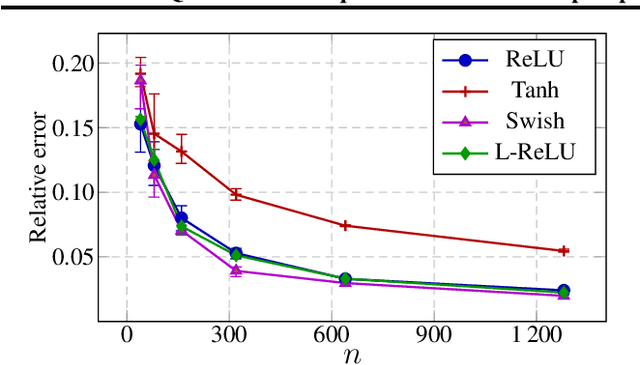
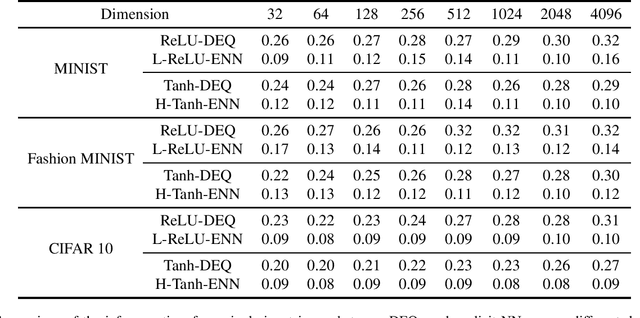
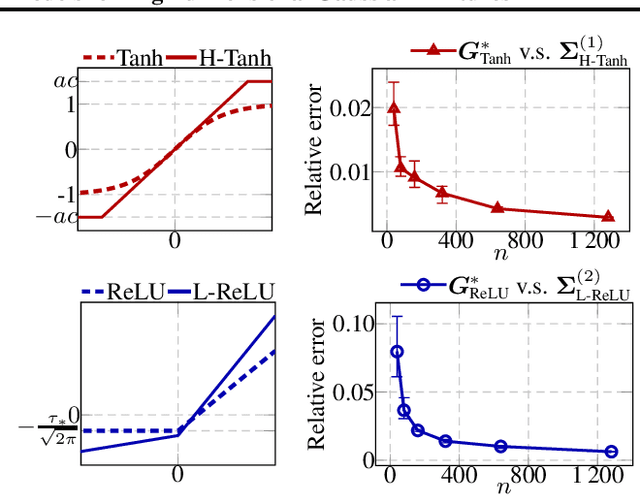
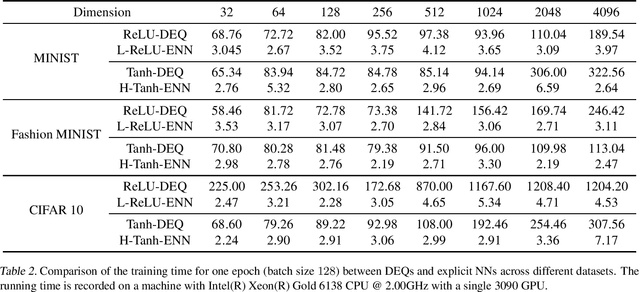
Abstract:Deep equilibrium models (DEQs), as a typical implicit neural network, have demonstrated remarkable success on various tasks. There is, however, a lack of theoretical understanding of the connections and differences between implicit DEQs and explicit neural network models. In this paper, leveraging recent advances in random matrix theory (RMT), we perform an in-depth analysis on the eigenspectra of the conjugate kernel (CK) and neural tangent kernel (NTK) matrices for implicit DEQs, when the input data are drawn from a high-dimensional Gaussian mixture. We prove, in this setting, that the spectral behavior of these Implicit-CKs and NTKs depend on the DEQ activation function and initial weight variances, but only via a system of four nonlinear equations. As a direct consequence of this theoretical result, we demonstrate that a shallow explicit network can be carefully designed to produce the same CK or NTK as a given DEQ. Despite derived here for Gaussian mixture data, empirical results show the proposed theory and design principle also apply to popular real-world datasets.
Mitigating Label Bias in Machine Learning: Fairness through Confident Learning
Dec 24, 2023



Abstract:Discrimination can occur when the underlying unbiased labels are overwritten by an agent with potential bias, resulting in biased datasets that unfairly harm specific groups and cause classifiers to inherit these biases. In this paper, we demonstrate that despite only having access to the biased labels, it is possible to eliminate bias by filtering the fairest instances within the framework of confident learning. In the context of confident learning, low self-confidence usually indicates potential label errors; however, this is not always the case. Instances, particularly those from underrepresented groups, might exhibit low confidence scores for reasons other than labeling errors. To address this limitation, our approach employs truncation of the confidence score and extends the confidence interval of the probabilistic threshold. Additionally, we incorporate with co-teaching paradigm for providing a more robust and reliable selection of fair instances and effectively mitigating the adverse effects of biased labels. Through extensive experimentation and evaluation of various datasets, we demonstrate the efficacy of our approach in promoting fairness and reducing the impact of label bias in machine learning models.
Revisiting Logistic-softmax Likelihood in Bayesian Meta-Learning for Few-Shot Classification
Oct 16, 2023



Abstract:Meta-learning has demonstrated promising results in few-shot classification (FSC) by learning to solve new problems using prior knowledge. Bayesian methods are effective at characterizing uncertainty in FSC, which is crucial in high-risk fields. In this context, the logistic-softmax likelihood is often employed as an alternative to the softmax likelihood in multi-class Gaussian process classification due to its conditional conjugacy property. However, the theoretical property of logistic-softmax is not clear and previous research indicated that the inherent uncertainty of logistic-softmax leads to suboptimal performance. To mitigate these issues, we revisit and redesign the logistic-softmax likelihood, which enables control of the \textit{a priori} confidence level through a temperature parameter. Furthermore, we theoretically and empirically show that softmax can be viewed as a special case of logistic-softmax and logistic-softmax induces a larger family of data distribution than softmax. Utilizing modified logistic-softmax, we integrate the data augmentation technique into the deep kernel based Gaussian process meta-learning framework, and derive an analytical mean-field approximation for task-specific updates. Our approach yields well-calibrated uncertainty estimates and achieves comparable or superior results on standard benchmark datasets. Code is publicly available at \url{https://github.com/keanson/revisit-logistic-softmax}.
 Add to Chrome
Add to Chrome Add to Firefox
Add to Firefox Add to Edge
Add to Edge